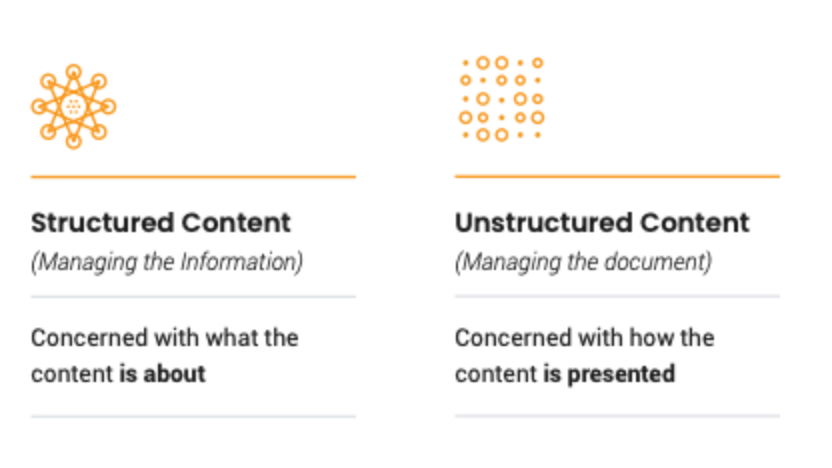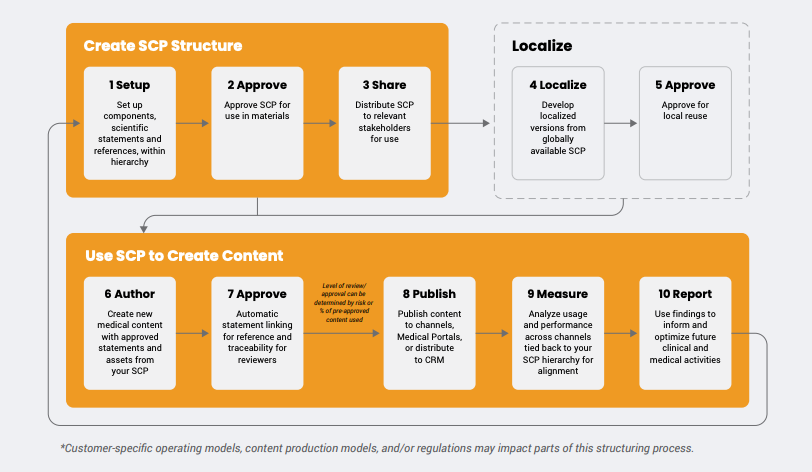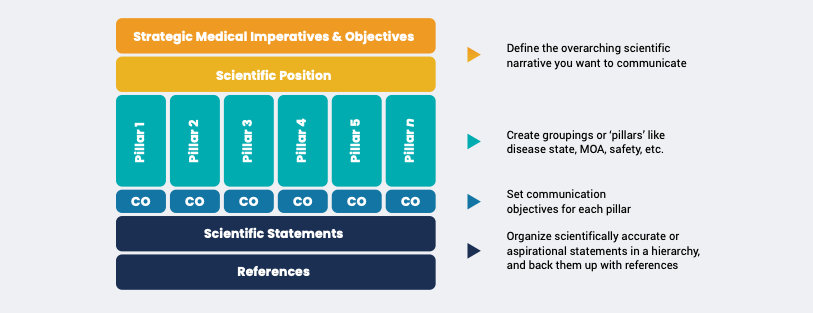eBook
Digitizing Your SCP:
A Modular Approach to Medical Content
Approaching modular content with a medical lens
Medical content is different from promotional content — it’s all about clinical data, real-world evidence, and scientific narratives. So, as you adopt a modular strategy for your medical content, why use a promotional approach? There are lessons to be learned from commercial models, but making modular work for medical starts by optimizing your scientific communication platform (SCP) and the processes that support it.
SCPs are inherently modular — key messages broken down into components and organized in a hierarchy in a single destination to communicate the science with the broader organization — but they need to evolve. As Rachel Kennedy, senior director and head of scientific communications at Moderna, says, “Most SCPs are not agile and disconnected from content creation. They are dated as soon as you roll them off the lot, like a used car starting to lose its value.”
In this eBook, you'll learn why SCPs are in need of transformation, how technology can help, and what you can do to effectively digitize your SCP.
“Most SCPs are not agile and disconnected from content creation. They are dated as soon as you roll them off the lot, like a used car starting to lose its value." Rachel Kennedy, Senior Director and Head of Scientific Communications, Moderna
Where traditional SCPs fall short
It takes months of cross-functional collaboration and strategic narrative development to produce an SCP. But their current state — large, monolithic documents containing hundreds of pages or slides — doesn't fully do this effort justice. Improving your SCP begins by fully understanding the challenges.- Storage risks
Downloadability is inherently bad for version control, and from an end-user perspective, it’s impossible to know when a document has changed or is in the process of changing. Some organizations spend significant time and budget converting the SCP into an internal-facing web page for easier sharing, but this approach isn’t agile and fails to solve complex review cycles. - Management gaps
SCPs are often not updated in real time as intended, and other materials are created or revised first. “The large number of stakeholders involved and the format makes SCP maintenance challenging, leading to less frequent updates than we’d like,” says Nick Gelyana, director of scientific content excellence at Astellas. - Disconnected use
Though SCPs provide clear direction for content creation, they are not systematically linked to the medical content created from them. Operationally, they’re often disconnected from content creation tools and not easily shared or accessible to content creators using them. This disconnect slows content development and limits visibility into where and how messages are being used, communicated, and ultimately understood and endorsed by HCPs.
“We should build SCPs and associated content like a spiderweb, connected through technology." Nick Gelyana, Director of Scientific Content Excellence, Astellas
The future of SCPs in the content supply chain
SCPs are often created and stored as large, isolated documents — hundreds of pages or slides in length. Containing your SCP in this type of monolithic format imposes practical limitations and disconnects it further from the content supply chain.
To make an SCP fundamental to the content supply chain, the information it contains needs to become usable within it. Refocus your effort on managing the information itself — the messages, data, and narratives that live in the SCP — rather than the document that contains it.

Structured content: Managing the information, not the document
Structured content is a method of organizing and managing information in a pre- defined logical way. A structured approach treats content like data. Information is broken down into format-free components that can be reused in different contexts. Tagging with metadata — data that describes other data — helps organize and categorize components in specific ways, such as by topic or target audience.
Not only does this streamline the content creation process, but the core information remains accurate and consistent regardless of how it is presented. Medical’s advantage is that the core information they need to communicate has a set structure already defined within the SCP itself — one that is inherently modular.
Structured content is FAIR:

Technology’s role in SCP transformation
Organizations have increasingly turned to innovation to disrupt conventional approaches to content management and better support omnichannel execution. The SCP is no different.
Technology can play a key role in connecting your SCP with the content processes it is designed to support. The hierarchical nature of SCPs provides agility when it comes to content development. By embedding it into your existing content supply chain, you can structure your SCP by its components and use them to create content in a modular fashion.
Embedding the SCP in your content supply chain*

With the SCP feature in Veeva Vault MedComms, you can create, organize, and manage your SCP centrally, and easily maintain it as a single source of truth. All your key messages and data are structured in the same ‘modular’ hierarchy as before and are closely tied to your content processes.
Breaking down the ‘modular’ messaging hierarchy

Your SCP becomes a set of reusable components to create content with consistent language and referencing. Because it’s interconnected, you have complete visibility into how and where your messages are being used externally and can use those insights to inform future clinical and medical activities.
Use cases: Connecting SCP to content creation

The benefits of digitizing your SCP in MedComms
Digitizing your SCP within MedComms creates a number of benefits that position your organization for broader success.
“The ultimate reason to have an SCP is to be superior at external engagement — to increase the effectiveness of your scientific exchange." Rachel Kennedy, Moderna
Speak to customers with one voice
At the core of SCPs are scientific messages — concise scientific statements with critical supporting references — that help HCPs understand the clinical data, therapeutic applications, and how to identify the right patients for treatment. Commercial content must align with the same narrative frameworks and communication objectives, forming the basis of claims used in promotional materials.
Digitizing your SCP ensures those messages remain accurate, consistent, and traceable regardless of how they are formatted in content and delivered downstream.
- Accuracy
Ensures scientific messages are accurate and up to date, supported by evidence and automated reference linking. - Consistency
Provides a single source of truth for your scientific exchange, no matter the engagement tactic, channel, or region. - Traceability
Tracks where and how your scientific messages are used and their effectiveness. Use these insights to inform future clinical and medical activities.
“If we can break the SCP down into its functional parts, it starts to become manageable and feel intuitive; there’s nothing stopping you from having this expansive view, a deeper exploration of all the science." Nick Gelyana, Astellas
Improve operational effectiveness
When digitized, SCPs become agile, as do the operational processes that surround them. All stakeholders can access a single source of truth, ensuring everyone is working with the same information and has clear visibility into who’s made what changes and when.
As new evidence emerges or the scientific landscape evolves, a digitized SCP provides the flexibility to manage the necessary changes in stream, without compromising the integrity of the platform as a whole.
Say there is a regulatory change that impacts an individual component, for example, the relevant stakeholders can review that single update without involving or affecting any of the SCP components that haven’t been changed.
“At the end of the day, the real value in this is moving the needle, not in how we think about ourselves, but how other people think about us and our data. Ultimately that is the most valuable metric on if we succeeded or not." Rachel Kennedy, Moderna
Drive overall medical impact
Digitizing your SCP plays a key role in aligning scientific messages with strategic organizational goals and can drive measurable outcomes. By integrating scientific narratives with broader communication strategies, your content becomes a vehicle for optimizing scientific exchange and stakeholder engagement. In turn, medical affairs can demonstrate the tangible value of its scientific communications and offer insights into narrative reach, sentiment, and impact.
Getting Started
Strategy before systems: Creating your SCP
If you are not using an SCP today, but plan to develop one, here are key steps to consider as you get started:
- Define its purpose
Clearly outline the purpose of the SCP, including how the SCP is intended to be used and what sets it apart from other strategic resources within your organization. - Identify roles and responsibilities
Determine who in your organization needs visibility, who needs access, and who will ultimately be responsible for keeping your SCP up to date. Technology supports these efforts, but you need individuals who are dedicated to making the SCP a success. - Share practical use cases
SCPs can serve as valuable training tools for onboarding and communicating the pillars of a product, but their primary purpose is to support external communication. Provide practical examples of how the SCP can be used — whether it's guiding content creation or informing conversations with external stakeholders about the product it supports.
5 steps to effectively digitize your SCP
Start by reinforcing the basics. Establish a strong operational foundation and ensure all stakeholders understand the inherent value. Then, move on to the next iteration.- Review your current process
Review your existing process for developing and managing your SCP. Assess opportunities to break your SCP into modular components and identify ways to adapt workflows to a digital format. Identify gaps in your current process and opportunities for improvement prior to digitization. - Focus on the basics
Clean up your reference library and take stock of existing materials. Ensure all content is accurate, up to date, and properly organized to help streamline the digitization process. - Define supporting processes
Outline the team’s roles and responsibilities and define who will be responsible for each task. Develop a realistic timeline, and identify reviewers and approvers. - Engage stakeholders
Identify and engage internal stakeholders, often the same set of cross- functional stakeholders engaged to create the SCP. Facilitate discussions, clearly communicate objectives, and emphasize the value of digitizing your SCP. - Measure and iterate
Once digitization is underway, continuously review and audit results and gather feedback. Refine and enhance your approach accordingly, moving forward to the next iteration.
Learn more about digitizing your SCP in Veeva MedComms.
